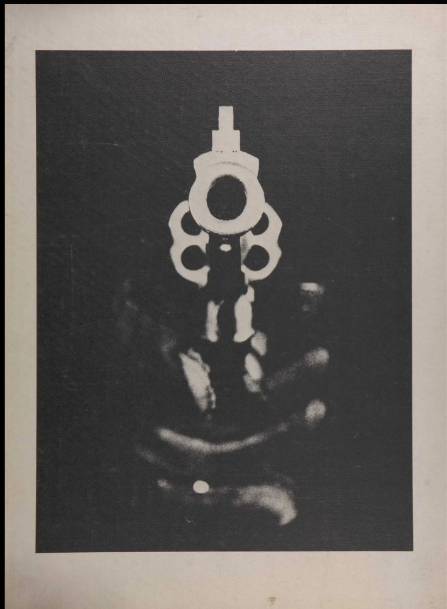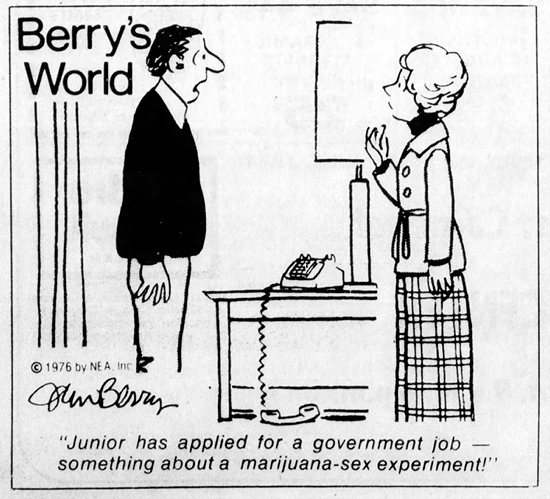1970s
Bailey’s Comets
The Wikipedia page.
According to Mark Arnold's book, Think Pink! The Story of DePatie-Freling Productions, producing the show was a nightmare, due to the massive amount of characters. Not only did the series do extremely poorly in the ratings, it got so costly to produce it nearly broke the studio, curtailing production for that year.
Posted By: Paul - Sun Aug 08, 2021 -
Comments (2)
Category: Contests, Races and Other Competitions, Fads, Ineptness, Crudity, Talentlessness, Kitsch, and Bad Art, Sports, Cartoons, 1970s
Mystery Illustration 102
What type of publication is this dramatic illustration from? A true-crime magazine? A government report on urban violence? Publicity for a cop movie?The answer is here.
Or after the jump.

More in extended >>
Posted By: Paul - Sat Aug 07, 2021 -
Comments (3)
Category: Photography and Photographers, 1970s, Weapons
The Fellowship for Human Happiness
1977: New York Attorney General Lous Lefkowitz ruled that "The Fellowship for Human Happiness" could no longer claim to be a church. It was instead, he decided, a house of prostitution masquerading as a church.Is there actually a rigorous legal test for determining what counts as a religion versus what doesn't? Or do judges (and Attorney Generals) just make determinations based on whether something feels appropriately religious to them? Google, so far, hasn't been able to supply me with an answer.

Tallahassee Democrat - Feb 10, 1977
Posted By: Alex - Wed Aug 04, 2021 -
Comments (10)
Category: Religion, 1970s
The Marijuana Sex Experiment
1975: There was a public hoo-ha when details of Dr. Harris Rubin's planned "marijuana sex study" leaked to the press. As described in the St. Louis Post-Dispatch (Dec 7, 1975):The New Scientist noted that, despite the moral outrage, the purpose of the study was actually to generate anti-marijuana propaganda by demonstrating that marijuana inhibits sexual response. At least, that was the anticipated result. But the experiment was never conducted.

Dr. Harris Rubin of the Southern Illinois University School of Medicine at Carbondale
Morton Hunt gives more details in his 1999 book The New Know-Nothings:
On July 18, the Bloomington, Illinois, Daily Pantagraph, which had somehow become aware of the study, ran an article about it, and from then on Rubin's project was in trouble. Newspapers in Illinois, St. Louis, Washington, Chicago, and many other cities ran stories about what quickly became known as the "sex-pot study" or "pot-sex study," a topic so interesting that they ran follow-up stories about it for many months. Displaying suitable outrage, the Christian Citizens Lobby, Illinois governor Daniel Walker, a federal prosecutor, and various Illinois state officials all denounced the study, calling it "disgusing," "pornography," "obscene," and "garbage," and threatening to take action against Rubin.
This was mere growling and snapping, but Congress had the teeth wherewith to bite. Senators William Proxmire and Thomas Eagleton, Democrats but sexual conservatives, attacked it, as did Representative Robert Michel, the ranking Republican member of the House Appropriations subcommittee. Although the secretary of HEW and the president's National Advisory Council on Drug Abuse defended and supported the project, Michel sought to prevent NIDA from funding the Rubin study by tucking an amendment to that effect in the $12.7 billion-dollar 1976 Supplemental Appropriations Bill for HEW, and Senators Proxmire and Warren Magnuson inserted a similar provision into the Senate's version of the bill. The funding of HEW was so crucial to the national well-being that both houses passed the bill with the anti-Rubin provision intact. President Ford signed it into law on May 31, 1976, keeping the vast Social Security system, NIH, and other essential endeavors going—and cutting off Rubin's minuscule funding and putting an end to his research. Rubin had already gathered the alcohol data and he eventually published his results, but the marijuana study died a-borning.

The Sedalia Democrat - Feb 4, 1976
Posted By: Alex - Sat Jul 31, 2021 -
Comments (6)
Category: Drugs, Smoking and Tobacco, Experiments, 1970s, Moral Panics and Public Hysteria
Disco Felon
A "disco felon" is a medical condition caused by snapping one's fingers too much to disco music. It was first reported in the New England Journal of Medicine.The original article is behind a paywall, but Edward Nash provided some details in the journal Science Year 1982:
The doctors treated the girl by draining and bandaging the inflammation. She recovered, but Walker and his associates sounded a dire warning to other disco dancers and their doctors. "Disco dancing may eventually be shown to damage a variety of body systems: namely visual, auditory, orthopedic, and nutritional. [Nutritional] damage might result from self-imposed starvation in an attempt... to wear the latest outfits."
A correspondent to the NEJM later suggested that "disco digit" might be a less confusing name for the condition.
Posted By: Alex - Tue Jul 27, 2021 -
Comments (3)
Category: Health, Music, 1970s
Smile
This film looks almost like a forerunner of famous mockumentaries such as Spinal Tap. It certainly fits into our theme of "odd beauty contests."Wikipedia page.
Posted By: Paul - Tue Jul 27, 2021 -
Comments (7)
Category: Awards, Prizes, Competitions and Contests, Beauty, Ugliness and Other Aesthetic Issues, Movies, 1970s, Satire
The Highest Streakers

I can find absolutely no supporting documentation of this event, but the photo comes from the Library of Congress, so it must be true!
Posted By: Paul - Sat Jul 24, 2021 -
Comments (1)
Category: Architecture, Fads, Public Indecency, 1970s
The Winooski Dome
In 1979, officials in Winooski, Vermont applied for a $55,000 federal grant to study the possibility of building a dome over the entire city. They explained that a dome might slash the cost of heating Winooski's buildings by up to 90 percent.They didn't actually have a plan for how the dome would be built, but they eventually enlisted the help of architect John Anderson who came up some ideas. Details from UnofficialNetworks.com:


Posted By: Alex - Fri Jul 23, 2021 -
Comments (1)
Category: Architecture, 1970s
Dr. Somers’ Cocaine Cure for Arthritis
Back in the late 1970s, Dr. Lowell Somers, chief of staff at Redbud Community Hospital, made headlines by claiming to have discovered that cocaine could cure arthritis. Somers explained that he discovered this by observing his identical twin cousins, Chuck and Rick. Chuck had arthritis, but Rick didn't. And Rick was a cocaine user, while Chuck wasn't.Somers said he had successfully treated a dozen rheumatoid patients with cocaine. His procedure:

Santa Rosa Press Democrat - Apr 13, 1979
It didn't take long for authorities to shut him down, which they did by charging that he was addicted to demerol and cocaine, and revoking his medical license. I guess he was taking the cure himself. Some info from The Oklahoman:
This sidestepped the issue of whether he may actually have been right about the medical benefit of cocaine for people with arthritis. It doesn't seem entirely implausible to me.
However, some googling pulls up an article suggesting that cocaine use may actually cause rheumatologic conditions. Although the authors admit they're not sure if the cocaine is the culprit, or the contaminants in the cocaine.
On the other hand, there's quite a bit of literature about the potential medical benefits of coca leaves, which people have been consuming in South America for thousands of years. Although coca leaves are a far cry from the pure cocaine Somers was using.

Santa Rosa Press Democrat - Apr 13, 1979
Posted By: Alex - Thu Jul 15, 2021 -
Comments (0)
Category: Drugs, Health, Medicine, 1970s
The Resurrection of Gladys Rogers
When 80-year-old Gladys Rogers died of flu in 1978, her evangelist son decided that he would freeze her body and then bring her back to life with prayer. Her resurrection, he believed, would turn people to Christianity. She lay in an upright freezer as he prayed.
St. Joseph Gazette - Mar 13, 1978
He prayed for two months before conceding that he had failed. He attributed his failure to a lack of faith. "It had nothing to do with the power of the Lord," he said. "The main thing was I can't bring mama back, but I'll meet her again in Heaven."
More info: Springfield News-Leader

Miami Herald - Apr 1, 1978
Posted By: Alex - Fri Jul 09, 2021 -
Comments (2)
Category: Death, Religion, 1970s

| Who We Are |
|---|
| Alex Boese Alex is the creator and curator of the Museum of Hoaxes. He's also the author of various weird, non-fiction, science-themed books such as Elephants on Acid and Psychedelic Apes. Paul Di Filippo Paul has been paid to put weird ideas into fictional form for over thirty years, in his career as a noted science fiction writer. He has recently begun blogging on many curious topics with three fellow writers at The Inferior 4+1. Contact Us |




